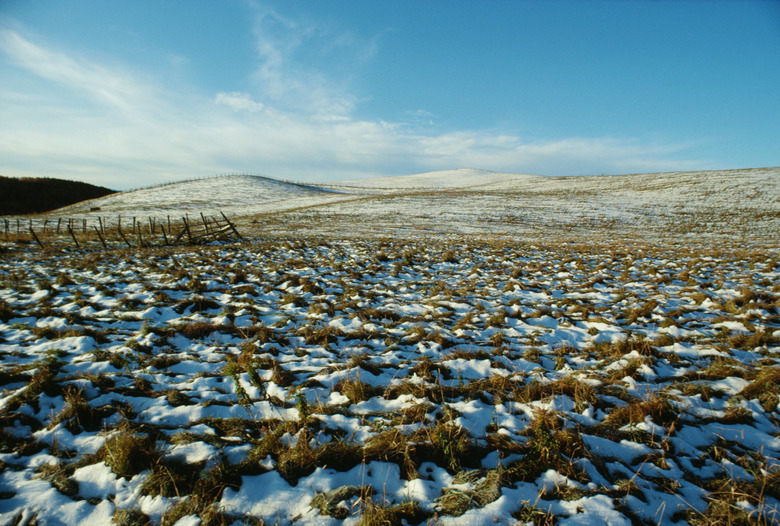What Is The Human Impact On The Tundra?
Derived from the Finnish word tunturi, which means 'treeless plain,' the tundra is regarded as one of the coldest and most environmentally challenging biomes on the planet. Although tundra ecosystems can be found at high elevations throughout the world, the term is most commonly used in relation to the Arctic tundra, which is located in the northern regions between the North Pole and the boreal forests in North America, Europe and Asia.
Characteristics of Arctic tundra environments include an extremely cold climate, low biological diversity, high winds and a permanently frozen subsoil layer termed permafrost. Due to its northerly location and frigid temperatures, there is only a short vegetation growing season of approximately 50 to 60 days.
Due to the extreme climate and limited opportunities for plant growth, the tundra ecosystem is extremely sensitive to disturbance. Human activities and development in the region can result in many negative impacts to the ecosystem. Major threats to the tundra biome and wildlife include exploitation of resources, overhunting and climate change.
Exploitation of Resources
Exploitation of Resources
Human impact in the tundra biome is most obvious in the exploration and development of mining, oil, gas and other extractive industries. Due to slow vegetation growth, clearing for oil fields, pipelines, roads and other infrastructure leaves soil exposed for considerable periods of time. This significantly reduces biological activity and increases the rate of erosion. Run-off from erosion, often exacerbated by altered hydrological systems from drains, culverts and the de-watering of mining pits, can also smother and otherwise impact vegetation further afield.
The extraction and transport of oil and the use of toxic chemicals in mining operations can lead to the release of these pollutants into the Arctic environment.
Hunting and Animal Control
Hunting and Animal Control
The muskox has been hunted by Arctic peoples for thousands of years, but by the early twentieth century modern hunting had wiped out the species in Alaska, Europe and Russia and significantly reduced their population in Canada and Greenland. A ban on muskox hunting and reintroduction efforts have helped this species recover, but their range and population remain significantly reduced from their historical levels.
Although not actively hunted to a significant extent, polar bears may be killed when they come into contact with humans. Climate change is increasing the frequency of these events, as hungry bears search populated areas for discarded food and other edible materials.
Atmospheric Pollution
Atmospheric Pollution
Atmospheric emissions from human activity can impact the delicate Arctic ecology. Black carbon fumes from diesel engines, fires and other forms of combustion can settle on snow, causing it to absorb more solar energy and melt at a faster rate. This can particularly affect animals that rely on snow cover for shelter, such as small rodents, or for camouflage, as do polar bears, Arctic foxes and Arctic hares.
Aerosols, coolants and other gases in can diminish the ozone layer when released into the atmosphere. The ozone layer deflects ultraviolet rays, and a lessening of this effect can increase the intensity of sunshine. This leads to localized warming and faster snow melt.
Climate Change
Climate Change
The Arctic regions are particularly sensitive to the effects of climate change. While living in tundra regions, the polar bear also relies on sea ice formed in the winter months to hunt its preferred prey of seals. Warmer winters have significantly reduced the extent and duration of these ice floes, resulting in starvation and unnatural behavior in these animals.
A warming climate can also result in an increase of non-native and invasive species which compete with local wildlife for resources. The range of the red fox has been steadily increasing northward, where they hunt nesting migratory birds and their eggs. They also compete directly with the smaller Artic fox for food and have been known to drive them from their dens.
Cite This Article
MLA
Michelle, Meg. "What Is The Human Impact On The Tundra?" sciencing.com, https://www.sciencing.com/what-is-the-human-impact-on-the-tundra-13427779/. 30 September 2021.
APA
Michelle, Meg. (2021, September 30). What Is The Human Impact On The Tundra?. sciencing.com. Retrieved from https://www.sciencing.com/what-is-the-human-impact-on-the-tundra-13427779/
Chicago
Michelle, Meg. What Is The Human Impact On The Tundra? last modified August 30, 2022. https://www.sciencing.com/what-is-the-human-impact-on-the-tundra-13427779/
